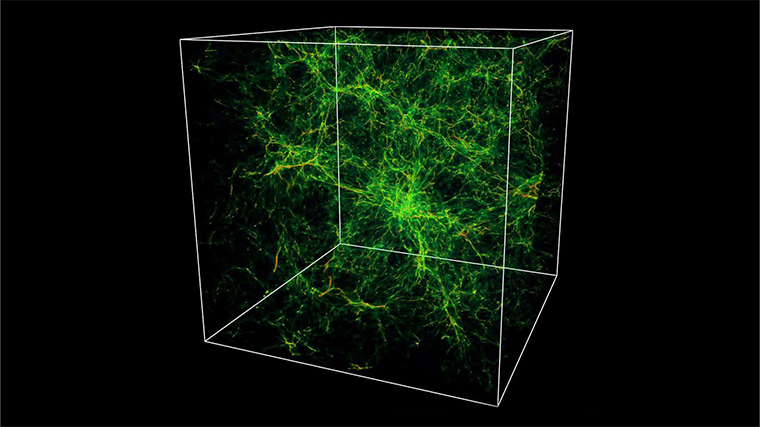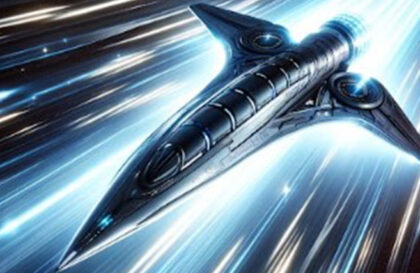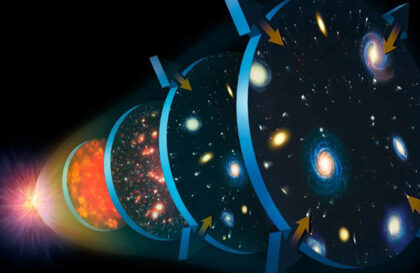When an object moves at close to the speed of light, time slows down for it, and the length of the object decreases. This can be seen in the example of astronauts on the ISS, which is moving at a speed of 7.66 km/s relative to the Earth. For them, time moves slower by 0.007 seconds relative to the Earth. Also, at the speed of light, the field of view is transformed into a tunnel in front of the flying spaceship.
How long does it take to fly at the speed of light to…
The average distance to the Moon is approximately 380,000 km. This means that a beam of light emitted from the surface of the Earth will take about 1.3 seconds to reach the surface of the Moon.
One astronomical unit equals approximately 150 million kilometers (the average distance from the Sun to the Earth). Light travels from the Sun to Earth in about 500 seconds (8 minutes 20 seconds).
The average distance from the Sun to Pluto is approximately 5.25 light hours.
The closest star to us (not counting the Sun), Proxima Centauri, is located 4.2 light years away.
The center of our Milky Way Galaxy is approximately 26,000 light-years from the Sun.
The closest cluster of galaxies, the Virgo cluster, is 58 million light-years away. This is how much light travels from there to the Earth.
How long will it take to cover a distance of one light-year?
A light year is the distance light travels in a vacuum in one year. This is about 10 trillion kilometers.
If we move at the speed of light c, we will cover one light year in one year.
If our speed is half the speed of light, then two years.
Breakthrough Starshot ships (Founders of the Breakthrough Starshot project are Yuri Milner and Stephen Hawking, on the board of Mark Zuckerberg) will supposedly travel at a speed of 0.2s: ~ 5 years.
At the speed of the fastest artificial object in human history, the Parker probe is about 192 km/s: ~ 1650 years.
At the speed of a hydrogen atom in the Sun’s core: ~ 15,500 years
At the speed of the fastest aircraft in the world (Boeing X-43 reached a speed of 9.5 times the speed of sound – 11,230 km/h): ~ 305.975 years
At the speed of sound 335 m/sec: ~ 882327 years
At a car speed on a highway of 130 km/h: ~ 8,388,270 years
At a walking speed of 5 km/h: ~ 215.993.799 years
At a snail’s pace of 0.047 km/h or 1.5 mm/s or 6 cm/min: ~ 83,304,201,370,000 years
Is it possible to move at the speed of light?
If an object moves at 10% of the speed of light, its mass will increase by 0.5% of its original mass. At the same time, if an object moves at 90% of the speed of light, its mass will double.
The speed of light is almost 300 thousand kilometers per second (299,792,458 meters per second or 1,079,252,848.8 km/h) in a vacuum, and when an object travels at this speed, its mass becomes infinite. Therefore, it would take infinite energy to move this object.
As for moving almost at the speed of light, say 90% of it, exciting observations await us.
What will happen if you move at 90% of the speed of light or 270 thousand km/s?
1. For example, if a person moves at 90% of the speed of light, then when 10 minutes have passed for him, 20 minutes have passed for a person standing still.
2. When a spacecraft moves at the speed of light, the Universe appears compressed in the window before it. Stars in front turn blue because their light waves are compressed, and stars behind them turn red because they are stretched. This is called the Doppler effect.
3. After passing a certain point, a person would be plunged into darkness since the wavelengths entering his eyes would be outside the visible spectrum.
4. At speeds of hundreds of millions of kilometers per hour in space, even the smallest particles become dangerous, turning into high-energy projectiles that can penetrate a ship. Hydrogen dispersed in space at such speeds can cause radiative forcing. At 95% of the speed of light, this will lead to rapid heating of the ship to melting temperatures and instant death of the crew due to the boiling of water in the body.
What happens if you move at 99.999999% of the speed of light?
The faster the spaceship moves, the stronger the time dilation effect. For example, on a ship traveling at 99.999999% of the speed of light, a year in Earth time corresponds to just over an hour for an astronaut. This phenomenon is known as relativistic time dilation. Thus, an astronaut who has spent months or years traveling may return to Earth to find that decades or even centuries have passed.
What happens if you exceed the light limit?
Exceeding the speed of light violates the law of causality, where the effect cannot precede the cause. For example, in a spacecraft moving faster than light, we would observe light emitted in the past as if time were going backward: first, we see photons from yesterday’s events, then from the day before yesterday, and so on. If the source of light were a mirror, we would see how the older man becomes younger, turning into a youth and then into a child, which is equivalent to moving from the present to the past and breaking the sequence of causes and effects.
From a technical point of view, It is important to note that no information or material object travels faster than the speed of light between two objects. Theoretically, we can calculate but cannot observe: they disappear from view.
Banner image: Generated by AI ChatGPT
Image credit:
https://drive.google.com






